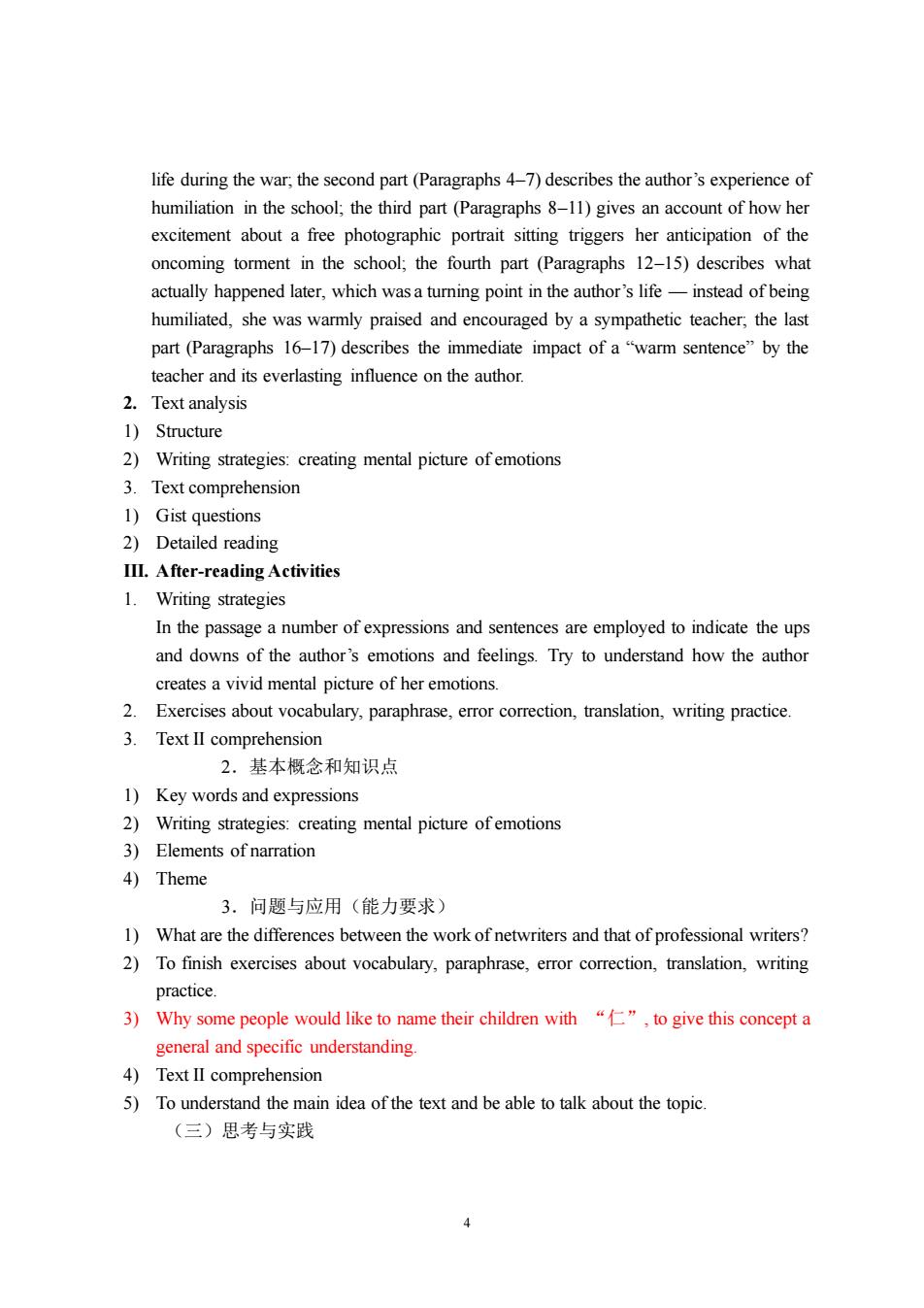正在加载图片...

life during the war,the second part(Paragraphs 4-7)describes the author's experience of humiliation in the school;the third part(Paragraphs 8-11)gives an account of how her excitement about a free photographic portrait sitting triggers her anticipation of the oncoming torment in the school;the fourth part (Paragraphs 12-15)describes what actually happened later,which wasa turning point in the author's life-instead of being humiliated,she was warmly praised and encouraged by a sympathetic teacher:the last part(Paragraphs 16-17)describes the immediate impact of a"warm sentence"by the teacher and its everlasting influence on the author. 2.Text analysis 1)Structure 2)Writing strategies:creating mental picture of emotions 3.Text comprehension 1)Gist questions 2)Detailed reading III.After-reading Activitie 1.Writing strategies In the passage a number of expressions and sentences are employed to indicate the ups and downs of the author's emotions and feelings.Try to understand how the author creates a vivid mental picture of her emotions 2.Exercises about vocabulary,paraphrase,error correction,translation,writing practice. 3.Text II comprehension 2.基本概念和知识点 1)Key words and expressions 2)Writing strategies:creating mental picture ofemotions 3) Elements of narration 4)Theme 3.问题与应用(能力要求) 1)What are the differences between the work of netwriters and that of professional writers? 2)To finish exercises about vocabulary,paraphrase,error correction,translation,writing practice. 3)Why some people would like to name their children with“仁”,to give this concept a general and specific understanding 4)Text II comprehension 5)To understand the main idea of the text and be able to talk about the topic (三)思考与实践4 life during the war; the second part (Paragraphs 4–7) describes the author’s experience of humiliation in the school; the third part (Paragraphs 8–11) gives an account of how her excitement about a free photographic portrait sitting triggers her anticipation of the oncoming torment in the school; the fourth part (Paragraphs 12–15) describes what actually happened later, which was a turning point in the author’s life — instead of being humiliated, she was warmly praised and encouraged by a sympathetic teacher; the last part (Paragraphs 16–17) describes the immediate impact of a “warm sentence” by the teacher and its everlasting influence on the author. 2. Text analysis 1) Structure 2) Writing strategies: creating mental picture of emotions 3. Text comprehension 1) Gist questions 2) Detailed reading III. After-reading Activities 1. Writing strategies In the passage a number of expressions and sentences are employed to indicate the ups and downs of the author’s emotions and feelings. Try to understand how the author creates a vivid mental picture of her emotions. 2. Exercises about vocabulary, paraphrase, error correction, translation, writing practice. 3. Text II comprehension 2.基本概念和知识点 1) Key words and expressions 2) Writing strategies: creating mental picture of emotions 3) Elements of narration 4) Theme 3.问题与应用(能力要求) 1) What are the differences between the work of netwriters and that of professional writers? 2) To finish exercises about vocabulary, paraphrase, error correction, translation, writing practice. 3) Why some people would like to name their children with “仁”, to give this concept a general and specific understanding. 4) Text II comprehension 5) To understand the main idea of the text and be able to talk about the topic. (三)思考与实践